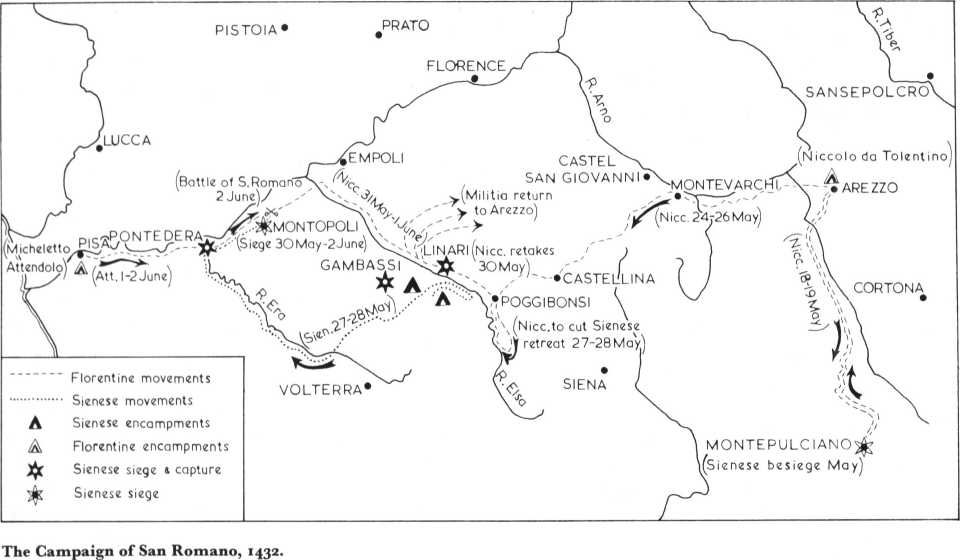m1360

S. Romano (1432)
The Rout of San Romano has been immortalised by Uccello’s famous paintings, but it was the large-scale manoeuvring that preceded this Florentine victory that madę it most interesting. Florence and Siena were once again at war. Niccolo da Tolentino, the Florentine Captain-General, was encamped near Arezzo while Micheletto Attendolo commanded a second Florentine force near Pisa. The Sienese were on the offensive, besieging the frontier fortress of Montepulciano and, aided by allied Milanese contingents, raiding the regions south of the River Arno from bases in the Flisa valley. Tolentino and 700 troops had tried to catch the Sienese com-mander, Francesco Piccinino, in a night ambush on 18 May but, failing to do so, had ridden south to deliver desperately needed supplies to Montepulciano. When news came that the Sienese were also close to capturing Linari and Gambassi, Tolentino decided to move fast. After three days spent collecting munitions, provisions and militia forces from the Arezzo area, he moved off at dawn on 24 May. About half of his 4,000 men were infantry, which slowed him down. News then came that Linari had fallen. On the 26th the Florentines reached Poggibonsi, where Tolentino heard that the two Sienese forces in the Elsa valley had joined to take Gambassi and were now movinghis way, towardsSiena. NextdayTolentino sent infantry and militia to besiege Linari, while he himself marched south to cut off the Sienese road home. Whether or not they had been retreating, the Sienese were next reported heading north-westtowardsPontedera. Sienese-held Linari and Gambassi now lay between Tolentino and his foe. Despite a lack ofheavy artillery, the Florentine Captain-General determined to retake Linari rather than leave it as a threat to his rear.
The siege of 30 May was short and bitter, with heavy casualties. Linari was then razed to make it useless to an enemy while Tolentino led a forced march down the Elsa valley towards the Arno. Now he lost most of his Arezzine militia, who were getting too far from their homes and who had seen enough fighting. Although 1 June was a Sunday, normally a day of rest in Italian con-dottiere warfare, Tolentino would allow his men no repite when they reached the Arno. Instead they moved rapidly west towards the Sienese who, having taken Pontedera, were now besieging Montopoli from their camp at S. Romano. The Captain-General madę a personal reconnaissance
30
Wyszukiwarka
Podobne podstrony:
jff 119 GLOSSARY The use of Japanese terms has been kept to a minimum in this book. It is an imposit
earthquakes have been analyzed (69]; the disperslon of such waves has been used to determłne models&
cially EU has undertaken a lot of activities to achieve this goal. The category of micro entities ha
r With the development of medianę doctors ca mc to be mterested in cos-metology. It was in France th
mbs 073 MY BREATHING SYSTEM Even if the heart has been weakened by athletics badly per-formed, it is
1 (151) Strona 12 z 46 Spy Circuits - 5v for maximum output. The Voyager has been copied by many kit
Augustinian (Social Sciences and Humanities Journal of the University of San
10 W. R. ANTARKAR Prof. H. Nakamura has madę a similar aitempl to arrive at the datę of Sań. by corr
The goal of our thesis is to reflect on this legislative ban as it is seeing in France and in Quebec
99. B.96796 THE FUTURĘ of public employee retirement systems / ed. by 01ivia S. Mi
więcej podobnych podstron